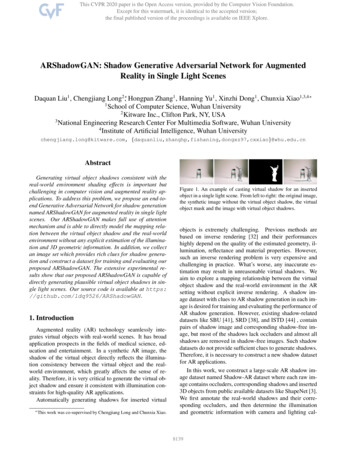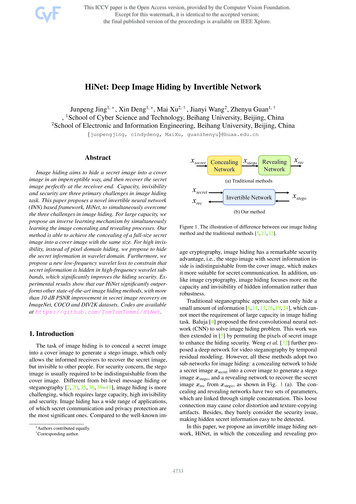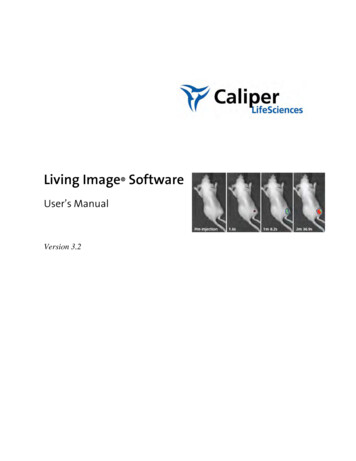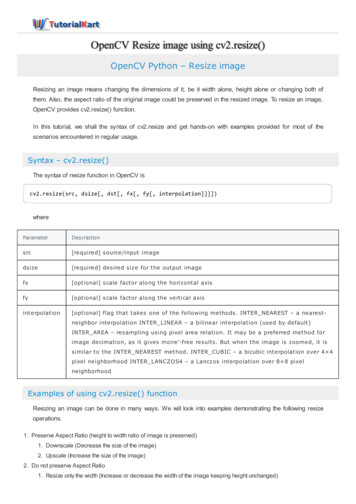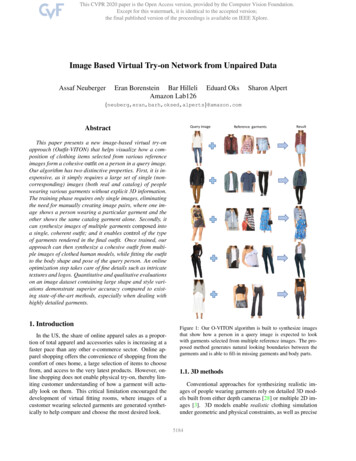
Transcription
Image Based Virtual Try-on Network from Unpaired DataAssaf NeubergerEran Borenstein Bar HilleliAmazon Lab126Eduard OksSharon Query imageAbstractReference garmentsResultThis paper presents a new image-based virtual try-onapproach (Outfit-VITON) that helps visualize how a composition of clothing items selected from various referenceimages form a cohesive outfit on a person in a query image.Our algorithm has two distinctive properties. First, it is inexpensive, as it simply requires a large set of single (noncorresponding) images (both real and catalog) of peoplewearing various garments without explicit 3D information.The training phase requires only single images, eliminatingthe need for manually creating image pairs, where one image shows a person wearing a particular garment and theother shows the same catalog garment alone. Secondly, itcan synthesize images of multiple garments composed intoa single, coherent outfit; and it enables control of the typeof garments rendered in the final outfit. Once trained, ourapproach can then synthesize a cohesive outfit from multiple images of clothed human models, while fitting the outfitto the body shape and pose of the query person. An onlineoptimization step takes care of fine details such as intricatetextures and logos. Quantitative and qualitative evaluationson an image dataset containing large shape and style variations demonstrate superior accuracy compared to existing state-of-the-art methods, especially when dealing withhighly detailed garments.1. IntroductionIn the US, the share of online apparel sales as a proportion of total apparel and accessories sales is increasing at afaster pace than any other e-commerce sector. Online apparel shopping offers the convenience of shopping from thecomfort of ones home, a large selection of items to choosefrom, and access to the very latest products. However, online shopping does not enable physical try-on, thereby limiting customer understanding of how a garment will actually look on them. This critical limitation encouraged thedevelopment of virtual fitting rooms, where images of acustomer wearing selected garments are generated synthetically to help compare and choose the most desired look.Figure 1: Our O-VITON algorithm is built to synthesize imagesthat show how a person in a query image is expected to lookwith garments selected from multiple reference images. The proposed method generates natural looking boundaries between thegarments and is able to fill-in missing garments and body parts.1.1. 3D methodsConventional approaches for synthesizing realistic images of people wearing garments rely on detailed 3D models built from either depth cameras [28] or multiple 2D images [3]. 3D models enable realistic clothing simulationunder geometric and physical constraints, as well as precise15184
control of the viewing direction, lighting, pose and texture.However, they incur large costs in terms of data capture, annotation, computation and in some cases the need for specialized devices, such as 3D sensors. These large costs hinder scaling to millions of customers and garments.1.2. Conditional image generation methodsRecently, more economical solutions suggest formulating the virtual try-on problem as a conditional image generation one. These methods generate realistic looking images of people wearing their selected garments from twoinput images: one showing the person and one, referred toas the in-shop garment, showing the garment alone. Thesemethods can be split into two main categories, depending onthe training data they use: (1) Paired-data, single-garmentapproaches that use a training set of image pairs depictingthe same garment in multiple images. For example, image pairs with and without a person wearing the garment(e.g. [10, 30]), or pairs of images presenting a specific garment on the same human model in two different poses. (2)Single-data, multiple-garment approaches (e.g. [25]) thattreat the entire outfit (a composition of multiple garments)in the training data as a single entity. Both types of approaches have two main limitations: First, they do not allow customers to select multiple garments (e.g. shirt, skirt,jacket and hat) and then compose them together to fit withthe customer’s body. Second, they are trained on data thatis nearly unfeasible to collect at scale. In the case of paireddata, single-garment images, it is hard to collect severalpairs for each possible garment. In the case of single-data,multiple-garment images it is hard to collect enough instances that cover all possible garment combinations.1.3. NoveltyIn this paper, we present a new image-based virtual tryon approach that: 1) Provides an inexpensive data collection and training process that includes using only single 2Dtraining images that are much easier to collect at scale thanpairs of training images or 3D data.2) Provides an advanced virtual try-on experience by synthesizing images of multiple garments composed into a single, cohesive outfit (Fig.2) and enables the user to controlthe type of garments rendered in the final outfit.3) Introduces an online optimization capability for virtualtry-on that accurately synthesizes fine garment features liketextures, logos and embroidery.We evaluate the proposed method on a set of images containing large shape and style variations. Both quantitativeand qualitative results indicate that our method achievesbetter results than previous methods.2. Related Work2.1. Generative Adversarial NetworksGenerative adversarial networks (GANs) [7, 27] are generative models trained to synthesize realistic samples thatare indistinguishable from the original training data. GANshave demonstrated promising results in image generation[24, 17] and manipulation [16]. However, the original GANformulation lacks effective mechanisms to control the output.Conditional GANs (cGAN) [21] try to address this issue by adding constraints on the generated examples. Constraints utilized in GANs can be in the form of class labels[1], text [36], pose [19] and attributes [29] (e.g. mouthopen/closed, beard/no beard, glasses/no glasses, gender).Isola et al. [13] suggested an image-to-image translationnetwork called pix2pix, that maps images from one domainto another (e.g. sketches to photos, segmentation to photos).Such cross-domain relations have demonstrated promisingresults in image generation. Wang et al.’s pix2pixHD [31]generates multiple high-definition outputs from a singlesegmentation map. It achieves that by adding an autoencoder that learns feature maps that constrain the GAN andenable a higher level of local control. Recently, [23] suggested using a spatially-adaptive normalization layer thatencodes textures at the image-level rather than locally. Inaddition, composition of images has been demonstrated using GANs [18, 35], where content from a foreground imageis transferred to the background image using a geometrictransformation that produces an image with natural appearance. Fine-tuning a GAN during test phase has been recently demonstrated [34] for facial reenactment.2.2. Virtual try-onThe recent advances in deep neural networks have motivated approaches that use only 2D images without any 3Dinformation. For example, the VITON [10] method usesshape context [2] to determine how to warp a garment imageto fit the geometry of a query person using a compositionalstage followed by geometric warping. CP-VITON [30],uses a convolutional geometric matcher [26] to determinethe geometric warping function. An extension of this workis WUTON [14], which uses an adversarial loss for morenatural and detailed synthesis without the need for a composition stage. PIVTONS [4] extended [10] for pose-invariantgarments and MG-VTON [5] for multi-posed virtual try-on.All the different variations of original VITON [10] require a training set of paired images, namely each garmentis captured both with and without a human model wearingit. This limits the scale at which training data can be collected since obtaining such paired images is highly laborious. Also, during testing only catalog (in-shop) images ofthe garments can be transferred to the person’s query im5185
ReferenceimagesShapefeature slice8𝑥4𝑥𝐷' Shapegenerationnetwork nReferenceimagesAppearancefeature map Query image ure ���𝑥𝐷&Shapefeature map𝐻𝑥𝑊𝑥𝐷& ance GenerationShape ��&8𝑥4𝑥𝐷' 𝐷&Query bodymodel1𝑥𝐷)𝐷& 𝑥𝐷)AppearanceAutoencoderShapeAutoencoder Instance-wisebroadcast𝐻𝑥𝑊𝑥𝐷)Query image𝐻𝑥𝑊𝑥3DensePose𝐷& rFigure 2: Our O-VITON virtual try-on pipeline combines a query image with garments selected from reference images to generate acohesive outfit. The pipeline has three main steps. The first shape generation step generates a new segmentation map representing thecombined shape of the human body in the query image and the shape feature map of the selected garments, using a shape autoencoder.The second appearance generation step feed-forwards an appearance feature map together with the segmentation result to generate an aphoto-realistic outfit. An online optimization step then refines the appearance of this output to create the final outfit.age. In [32], a GAN is used to warp the reference garmentonto the query person image. No catalog garment imagesare required, however it still requires corresponding pairsof the same person wearing the same garment in multipleposes. The works mentioned above deal only with the transfer of top-body garments (except for [4], which applies toshoes only). Sangwoo et al [22], apply segmentation masksto allow control over generated shapes such as pants transformed to skirts. However, in this case only the shape of thetranslated garment is controlled. Furthermore, each shapetranslation task requires its own dedicated network. Therecent work of [33] generates images of people wearingmultiple garments. However, the generated human modelis only controlled by pose rather than body shape or appearance. Additionally, the algorithm requires a training set ofpaired images of full outfits, which is especially difficult toobtain at scale. The work of [25] (SwapNet) swaps entireoutfits between two query images using GANs. It has twomain stages. Initially it generates a warped segmentationof the query person to the reference outfit and then overlays the outfit texture. This method uses self-supervisionto learn shape and texture transfer and does not require apaired training set. However, it operates at the outfit-levelrather than the garment-level and therefore lacks composability. The recent works of [9, 12] also generate fashionimages in a two-stage process of shape and texture generation.3. Outfit Virtual Try-on (O-VITON)Our system uses multiple reference images of peoplewearing garments varying in shape and style. A user canselect garments within these reference images to receive analgorithm-generated outfit output showing a realistic imageof their personal image (query) dressed with these selectedgarments.Our approach to this challenging problem is inspired bythe success of the pix2pixHD approach [31] to image-toimage translation tasks. Similar to this approach, our generator G is conditioned on a semantic segmentation map andon an appearance map generated by an encoder E. The autoencoder assigns to each semantic region in the segmentation map a low-dimensional feature vector representing theregion appearance. These appearance-based features enablecontrol over the appearance of the output image and addressthe lack of diversity that is frequently seen with conditionalGANs that do not use them.Our virtual try-on synthesis process (Fig.2) consists ofthree main steps: (1) Generating a segmentation map thatconsistently combines the silhouettes (shape) of the selectedreference garments with the segmentation map of the queryimage. (2) Generating a photo-realistic image showing theperson in the query image dressed with the garments selected from the reference images. (3) Online optimizationto refine the appearance of the final output image.We describe our system in more detail: Sec.3.1 describesthe feed-forward synthesis pipeline with its inputs, components and outputs. Sec.3.2 describes the training processof both the shape and appearance networks and Sec.3.3 describes the online optimization used to fine-tune the outputimage.5186
3.1. Feed-Forward Generation3.1.1System InputsThe inputs to our system consist of a H W RGB queryimage x0 having a person wishing to try on various garments. These garments are represented by a set of M additional reference RGB images (x1 , x2 , . . . xM ) containingvarious garments in the same resolution as the query imagex0 . Please note that these images can be either natural images of people wearing different clothing or catalog imagesshowing single clothing items. Additionally, the numberof reference garments M can vary. To obtain segmentation maps for fashion images, we trained a PSP [37] semantic segmentation network S which outputs sm S(xm )of size H W Dc with each pixel in xm labeled as oneof Dc classes using a one-hot encoding. In other words,s(i, j, c) 1 means that pixel (i, j) is labeled as class c.A class can be a body part such as face / right arm or agarment type such as tops, pants, jacket or background. Weuse our segmentation network S to calculate a segmentationmap s0 of the query image and sm segmentation maps forthe reference images (1 m M,). Similarly, a DensePose network [8] which captures the pose and body shapeof humans is applied to estimate a body model b B(x0 )of size H W Db .3.1.2Shape Generation Network ComponentsThe shape-generation network is responsible for the firststep described above: It combines the body model b of theperson in the query image x0 with the shapes of the selectedgarments represented by {sm }Mm 1 (Fig. 2 green box). Asmentioned in Sec.3.1.1, the semantic segmentation map smassigns a one hot vector representation to every pixel inxm . A W H 1 slice of sm through the depth dimensionsm (·, ·, c) therefore provides a binary mask Mm,c representing the region of the pixels that are mapped to class c inimage xm .A shape autoencoder Eshape followed by a local pooling step maps this mask to a shape feature slice esm,c Eshape (Mm,c ) of 8 4 Ds dimensions. Each class c of theDc possible segmentation classes is represented by esm,c ,even if a garment of type c is not present in image m.Namely, it will input a zero-valued mask Mm,c into Eshape .When the user wants to dress a person from the queryimage with a garment of type c from a reference image m,we just replace es0,c with the corresponding shape featureslice of esm,c , regardless of whether garment c was presentin the query image or not. We incorporate the shape feature slices of all the garment types by concatenating themalong the depth dimension, which yields a coarse shape feature map ēs of 8 4 Ds Dc dimensions. We denote es asthe up-scaled version of ēs into H W Ds Dc dimensions.Essentially, combining different garment types for the queryimage is done just by replacing its corresponding shape features slices with those of the reference images.The shape feature map es and the body model b are fedinto the shape generator network Gshape to generate a new,transformed segmentation map sy of the query person wearing the selected reference garments sy Gshape (b, es ).3.1.3Appearance Generation Network ComponentsThe first module in our appearance generation network(Fig. 2 blue box) is inspired by [31] and takes RGB images and their corresponding segmentation maps (xm , sm )and applies an appearance autoencoder Eapp (xm , sm ). Theoutput of the appearance autoencoder is denoted as ētmof H W Dt dimensions. By region-wise average pooling according to the mask Mm,c we form a Dt dimensional vector etm,c that describes the appearance of this region. Finally, the appearance feature map etm is obtainedby a region-wise broadcast of the appearance feature vectors etm,c to their corresponding region marked by the maskMm,c . When the user selects a garment of type c from image xm , it simply requires replacing the appearance vectorfrom the query image et0,c with the appearance vector ofthe garment image etm,c before the region-wise broadcasting which produce the appearance feature map et .The appearance generator Gapp takes the segmentationmap sy generated by the preceding shape generation stageas the input and the appearance feature map et as the condition and generates an output y representing the feed-forwardvirtual try-on output y Gapp (sy , et ).3.2. Train PhaseThe Shape and Appearance Generation Networks aretrained independently (Fig.3) using the same training set ofsingle input images with people in various poses and clothing. In each training scheme the generator, discriminatorand autoencoder are jointly-trained.3.2.1Appearance Train phaseWe use a conditional GAN (cGAN) approach that is similar to [31] for image-to-image translation tasks. In cGANframeworks, the training process aims to optimize a Minimax loss [7] that represents a game where a generator Gand a discriminator D are competing. Given a trainingimage x the generator receives a corresponding segmentation map S(x) and an appearance feature map et (x) Eapp (x, S(x)) as a condition. Note that during the trainphase both the segmentation and the appearance featuremaps are extracted from the same input image x whileduring test phase the segmentation and appearance feature maps are computed from multiple images. We describe this step in Sec.3.1. The generator aims to synthe5187
SegmentationmapDensePosebody riginalsegmentationmapShape featuremapGeneratedsegmentation mapOriginalimageAppearancefeature mapGeneratedImageFigure 3: Train phase. (Left) Shape generator translates body model and shape feature map into the original segmentation map. (Right)Appearance generator translates segmentation map and appearance feature map into the original photo. Both training schemes use thesame dataset of unpaired fashion images.size Gapp (S(x), et (x)) that will confuse the discriminatorwhen it attempts to separate generated outputs from originalinputs such as x. The discriminator is also conditioned bythe segmentation map S(x). As in [31], the generator anddiscriminator aim to minimize the LSGAN loss [20]. Forbrevity we will omit the app subscript from the appearancenetwork components in the following equations.min LGAN (G) Ex [(D(S(x), G(S(x), et (x)) 1)2 ]Gmin LGAN (D) Ex [(D(S(x), x) 1)2 ] Ex [(D(S(x), G(S(x), et (x)))2 ]D(1)The architecture of the generator Gapp is similar to theone used by [15, 31], which consists of convolution layers, residual blocks and transposed convolution layers forup-sampling. The architecture of the discriminator Dapp isa PatchGAN [13] network, which is applied to multiple image scales as described in [31]. The multi-level structureof the discriminator enables it to operate both at the coarsescale with a large receptive field for a more global view, andat a fine scale which measures subtle details. The architecture of E is a standard convolutional autoencoder network.In addition to the adversarial loss, [31] suggested an additional feature matching loss to stabilize the training andforce it to follow natural images statistics at multiple scales.In our implementation, we add a feature matching loss,suggested by [15], that directly compares between generated and real images activations, computed using a pretrained perceptual network (VGG-19). Let φl be the vector form of the layer activation across channels with dimensions Cl Hl ·Wl . We use a hyper-parameter λl to determine the contribution of layer l to the loss. This loss isdefined as:LF M (G) ExXλl φl (G(S(x), et (x))) φl (x) 2Fl(2)We combine these losses together to obtain the loss func-tion for the Appearance Generation Network:Ltrain (G, D) LGAN (G, D) LF M (G)3.2.2(3)Shape Train PhaseThe data for training the shape generation network is identical to the training data used for the appearance generationnetwork and we use a similar conditional GAN loss for thisnetwork as well. Similar to decoupling appearance fromshape, described in 3.2.1, we would like to decouple thebody shape and pose from the garment’s silhouette in order to transfer garments from reference images to the queryimage at test phase. We encourage this by applying a distinct spatial perturbation for each slice s(·, ·, c) of s S(x)using a random affine transformation. This is inspired bythe self-supervision described in SwapNet [25]. In addition, we apply an average-pooling to the output of Eshapeto map H W Ds dimensions, to 8 4 Ds dimensions.This is done for the test phase, which requires a shape encoding that is invariant to both pose and body shape. Theloss functions for Gshape and discriminator Dshape are similar to (3) with the generator conditioned on the shape feature es (x) rather than the appearance feature map et of theinput image. The discriminator aims to separate s S(x)from sy Gshape (S(x), es ). The feature matching loss in(2) is replaced by a cross-entropy loss LCE component thatcompares the labels of the semantic segmentation maps.3.3. Online OptimizationThe feed-forward operation of appearance network (autoencoder and generator) has two main limitations. First,less frequent garments with non-repetitive patterns are morechallenging due to both their irregular pattern and reducedrepresentation in the training set. Fig. 6 shows the frequencyof various textural attributes in our training set. The mostfrequent pattern is solid (featureless texture). Other frequent textures such as logo, stripes and floral are extremely5188
QueryImageReferencegarmentCP-VITONO-VITON O-VITON (ours)with online(ours) withfeed-forward optimizationQueryImageReference O-VITON O-VITON (ours)garment (ours) withwith onlinefeed-forward optimizationFigure 4: Single garment transfer results. (Left) Query image column; Reference garment; CP-VITON [30]; O-VITON (ours) methodwith feed-forward only; O-VITON (ours) method with online optimization. Note that the feed-forward alone can be satisfactory in somecases, but lacking in others. The online optimization can generate more accurate visual details and better body parts completion. (Right)Generation of garments other than shirts, where CP-VITON is not applicable.diverse and the attribute distribution has a relatively long tailof other less common non-repetitive patterns. This constitutes a challenging learning task, where the neural networkaims to accurately generate patterns that are scarce in thetraining set. Second, no matter how big the training set is, itwill never be sufficiently large to cover all possible garmentpattern and shape variations. We therefore propose an online optimization method inspired by style transfer [6]. Theoptimization fine-tunes the appearance network during thetest phase to synthesize a garment from a reference garmentto the query image. Initially, we use the parameters of thefeed-forward appearance network described in 3.1.3. Then,we fine-tune the generator Gapp (for brevity denoted as G)to better reconstruct a garment from reference image xm byminimizing the reference loss. Formally, given a referencegarment we use its corresponding region binary mask Mm,cwhich is given by sm in order to localize the reference loss(3):Lref (G) Xmtm m 2λl φml (G(S(x ), em )) φl (x ) Flmm (D (x , G(S(xm), etm ))) 1)2(4)Where the superscript m denotes localizing the loss bythe spatial mask Mm,c . To improve generalization for thequery image, we compare the newly transformed query segmentation map sy and its corresponding generated image yusing the GAN loss (1), denoted as query loss:Lqu (G) (Dm (sy , y) 1)2(5)Our online loss therefore combines both the reference gar-ment loss (4) and the query loss (5):Lonline (G) Lref (G) Lqu (G)(6)Note that the online optimization stage is applied for eachreference garment separately (see also Fig. 5). Since allthe regions in the query image are not spatially aligned, wediscard the corresponding values of the feature matchingloss (2).4. ExperimentsOur experiments are conducted on a dataset of people(both males and females) in various outfits and poses, thatwe scrapped from the Amazon catalog. The dataset is partitioned into a training set and a test set of 45K and 7K images respectively. All the images were resized to a fixed512 256 pixels. We conducted experiments for synthesizing single items (tops, pants, skirts, jackets and dresses) andfor synthesizing pairs of items together (i.e. top & pants).4.1. Implementation DetailsSettings: The architectures we use for the autoencodersEshape , Eapp , the generators Gshape , Gapp and discriminators Dshape , Dapp are similar to the corresponding components in [31] with the following differences. First, theautoencoders output have different dimensions. In our casethe output dimension is Ds 10 for Eshape and Dt 30for Eapp . The number of classes in the segmentation map isDc 20 and Db 27 dimensions for the body model. Second, we use single level generators Gshape , Gapp instead ofthe two level generators G1 and G2 because we are using alower 512 256 resolution. We train the shape and appearance networks using ADAM optimizer for 40 and 80 epochs5189
Referencegarment segGeneratedreference imageOriginalreference uerylossAppearanceDiscriminatorQuery imagesegFeed-forwardinitializationGeneratedquery tion gure 5: The online loss combines the reference and query lossesto improve the visual similarity between the generated outputand the selected garment, although both images are not spatiallyaligned. The reference loss is minimized when the generated reference garment (marked in orange contour) and the original photoof the reference garment are similar. The query loss is minimizedwhen the appearance discriminator ranks the generated query withthe reference garment as realistic.and batch sizes of 21 and 7 respectively. Other training parameters are lr 0.0002, β1 0.5, β2 0.999. Theonline loss (Sec.3.3) is also optimized with ADAM usinglr 0.001, β1 0.5, β2 0.999. The optimization is terminated when the online loss difference between two consecutive iterations is smaller than 0.5. In our experimentswe found that the process is terminated, on average, after80 iterations.Baselines: VITON [10] and CP-VITON [30] are thestate-of-the-art image-based virtual try-on methods thathave implementation available online. We focus mainly oncomparison with CP-VITON since it was shown (in [30])to outperform the original VITON. Note that in addition tothe differences in evaluation reported below, the CP-VITON(and VITON) methods are more limited than our proposedmethod because they only support generation of tops trainedon a paired dataset.Evaluation protocol: We adopt the same evaluationprotocol from previous virtual try-on approaches (i.e. [30,25, 10] ) that use both quantitative metrics and human subjective perceptual study. The quantitative metrics include:(1) Fréchet Inception Distance (FID) [11], that measures thedistance between the Inception-v3 activation distributionsof the generated vs. the real images. (2) Inception score(IS) [27] that measures the output statistics of a pre-trainedInception-v3 Network (ImageNet) applied to generated images.We also conducted a pairwise A/B test human evaluationstudy (as in [30]) where 250 pairs of reference and queryimages with their corresponding virtual try-on results (forboth compared methods) were shown to a human subject(worker). Specifically, given a person’s image and a target clothing image, the worker is asked to select the imagethat is more realistic and preserves more details of the targetclothes between two virtual try-on results.The comparison (Table 1) is divided into 3 variants: (1)synthesis of tops (2) synthesis of a single garment (e.g. tops,jackets, pants and dresses) (3) simultaneous synthesis oftwo garments from two different reference images (e.g. top& pants, top & jacket).4.2. Qualitative EvaluationFig. 4 (left) shows qualitative examples of our O-VITONapproach with and without the online optimization stepcompared with CP-VITON. For fair comparison we onlyinclude tops as CP-VITON was only trained to transfershirts. Note how the online optimization is able to better preserve the fine texture details of prints, logos andother non-repetitive patterns. In addition, the CP-VITONstrictly adheres to the silhouette of the original query outfit,whereas our method is less sensitive to the original outfitof the query person, generating a more natural look. Fig. 4(right) shows synthesis results with/without the online optimization step for jackets, dresses and pants. Both methods use the same shape generation step. We can see thatour approach successfully completes occluded regions likelimbs or newly exposed skin of the query human model.The online optimization step enables the model to adapt toshape and garment textures that do not appear in the training dataset. Fig. 1 shows that the level of detail synthesis isretained even if the suggested approach synthesized two orthree garments simultaneously.Failure cases Fig.7 shows failure cases of our methodcaused by infrequent poses, garments with unique silhouettes and garments with complex non-repetitive textures,which prove to be more challenging to the online
the training data they use: (1) Paired-data, single-garment approaches that use a training set of image pairs depicting the same garment in multiple images. For example, im-age pairs with and without a person wearing the garment (e.g. [10, 30]), or pairs of images presenting a specific gar-ment on the same human model in two different poses. (2)



